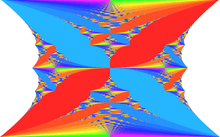Hofstadter's butterfly
In condensed matter physics, Hofstadter's butterfly describes the spectral properties of non-interacting two-dimensional electrons in a magnetic field. The fractal, self-similar nature of the spectrum was discovered in the 1976 Ph.D. work of Douglas Hofstadter[1] and is one of the early examples of computer graphics. The name reflects the visual resemblance of the figure on the right to a swarm of butterflies flying to infinity.

The Hofstadter butterfly plays an important role in the theory of the integer quantum Hall effect, and David J. Thouless won the Nobel Prize in physics in 2016 for the discovery[2] that the wings of the butterfly are characterized by Chern integers[3], the quantized Hall conductances discovered in 1980 by Klaus von Klitzing for which he won the Nobel Prize in 1985. The colors in the diagram reflect the different Chern numbers.
Background
Hofstadter described the structure in 1976 in an article on the energy levels of Bloch electrons in magnetic fields.[1] It gives a graphical representation of the spectrum of the almost Mathieu operator for at different frequencies. The intricate mathematical structure of this spectrum was discovered by Soviet physicist Mark Azbel in 1964 (the Azbel-Hofstadter model).[4] However, Azbel' did not plot the structure as a geometrical object.
Written while Hofstadter was at the University of Oregon, his paper was influential in directing further research. Hofstadter predicted on theoretical grounds that the allowed energy level values of an electron in a two-dimensional square lattice, as a function of a magnetic field applied to the system, formed what is now known as a fractal set. That is, the distribution of energy levels for small scale changes in the applied magnetic field recursively repeat patterns seen in the large-scale structure.[1] "Gplot", as Hofstadter called the figure, was described as a recursive structure in his 1976 article in Physical Review B,[1] written before Benoit Mandelbrot's newly coined word "fractal" was introduced in an English text. Hofstadter also discusses the figure in his 1979 book Gödel, Escher, Bach. The structure became generally known as "Hofstadter's butterfly".
Confirmation


In 1997 the Hofstadter butterfly was reproduced in experiments with microwave guide equipped by an array of scatterers.[5] Similarity of the mathematical description of the microwave guide with scatterers and of Bloch's waves in magnetic field allowed to reproduce the Hofstadter butterfly for periodic sequences of the scatterers.
In 2013, three separate groups of researchers independently reported evidence of the Hofstadter butterfly spectrum in graphene devices fabricated on hexagonal boron nitride substrates.[6][7][8] In this instance the butterfly spectrum results from interplay between the applied magnetic field, and the large scale moiré pattern that develops when the graphene lattice is oriented with near zero-angle mismatch to the boron nitride.
In September 2017, John Martinis group in Google, in collaboration with Angelakis group in CQT Singapore, published results from a simulation of 2D electrons in a magnetic field using interacting photons in 9 superconducting qubits. The simulation recovered Hofstadter's butterfly, as expected.[9]
References
- Hofstadter, Douglas R. (1976). "Energy levels and wavefunctions of Bloch electrons in rational and irrational magnetic fields". Physical Review B. 14 (6): 2239–2249. Bibcode:1976PhRvB..14.2239H. doi:10.1103/PhysRevB.14.2239.
- Thouless D. , Kohmoto M, Nightngale and M. den-Nijs (1982). "Quantized Hall conductance in a two dimensional periodic potential". Physical Review Letters. 49 (6): 405–408. Bibcode:1982PhRvL..49..405T. doi:10.1103/PhysRevLett.49.405.
- Avron J, Osadchy D., and Seiler R. (2003). "A topological look at the quantum Hall effect". Physics Today. 53: 38. doi:10.1063/1.1611351.
- Azbel', Mark Ya. (1964). "Energy Spectrum of a Conduction Electron in a Magnetic Field". Journal of Experimental and Theoretical Physics. 19 (3): 634–645.
- Kuhl, U.; Stöckmann, H.-J. (13 April 1998). "Microwave realization of the Hofstadter butterfly". Physical Review Letters. 80 (15): 3232–3235. Bibcode:1998PhRvL..80.3232K. doi:10.1103/PhysRevLett.80.3232.
- Dean, C. R.; Wang, L.; Maher, P.; Forsythe, C.; Ghahari, F.; Gao, Y.; Katoch, J.; Ishigami, M.; Moon, P.; Koshino, M.; Taniguchi, T.; Watanabe, K.; Shepard, K. L.; Hone, J.; Kim, P. (30 May 2013). "Hofstadter's butterfly and the fractal quantum Hall effect in moiré superlattices". Nature. 497 (7451): 598–602. arXiv:1212.4783. Bibcode:2013Natur.497..598D. doi:10.1038/nature12186. PMID 23676673.
- Ponomarenko, L. A.; Gorbachev, R. V.; Yu, G. L.; Elias, D. C.; Jalil, R.; Patel, A. A.; Mishchenko, A.; Mayorov, A. S.; Woods, C. R.; Wallbank, J. R.; Mucha-Kruczynski, M.; Piot, B. A.; Potemski, M.; Grigorieva, I. V.; Novoselov, K. S.; Guinea, F.; Fal’ko, V. I.; Geim, A. K. (30 May 2013). "Cloning of Dirac fermions in graphene superlattices". Nature. 497 (7451): 594–597. arXiv:1212.5012. Bibcode:2013Natur.497..594P. doi:10.1038/nature12187. hdl:10261/93894. PMID 23676678.
- Hunt, B.; Sanchez-Yamagishi, J. D.; Young, A. F.; Yankowitz, M.; LeRoy, B. J.; Watanabe, K.; Taniguchi, T.; Moon, P.; Koshino, M.; Jarillo-Herrero, P.; Ashoori, R. C. (2013). "Massive Dirac fermions and Hofstadter butterfly in a van der Waals heterostructure". Science. 340 (6139): 1427–1430. arXiv:1303.6942. Bibcode:2013Sci...340.1427H. doi:10.1126/science.1237240. PMID 23686343.
- Roushan, P.; Neill, C.; Tangpanitanon, J.; Bastidas, V. M.; Megrant, A.; Barends, R.; Chen, Y.; Chen, Z.; Chiaro, B.; Dunsworth, A.; Fowler, A.; Foxen, B.; Giustina, M.; Jeffrey, E.; Kelly, J.; Lucero, E.; Mutus, J.; Neeley, M.; Quintana, C.; Sank, D.; Vainsencher, A.; Wenner, J.; White, T.; Neven, H.; Angelakis, D. G.; Martinis, J. (2017-12-01) [2017-09-20]. "Spectroscopic signatures of localization with interacting photons in superconducting qubits" [Spectral signatures of many-body localization with interacting photons]. Science. 358 (6367): 1175–1179. arXiv:1709.07108. doi:10.1126/science.aao1401. ISSN 0036-8075. PMID 29191906.
